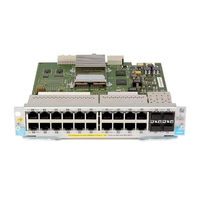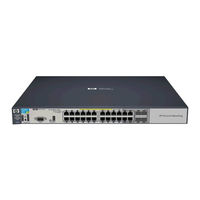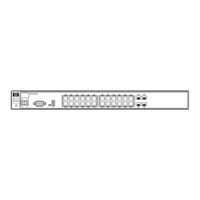HP J9470A Manuals
Manuals and User Guides for HP J9470A. We have 3 HP J9470A manuals available for free PDF download: Access Security Manual, Advanced Traffic Management Manual, Specification
HP J9470A Access Security Manual (778 pages)
Switch Software
Table of Contents
-
-
Introduction
35 -
Overview
55 -
-
Restrictions82
-
-
-
-
Overview
133 -
Terminology
141
-
-
-
Index.html167
-
Accept.html169
-
Authen.html170
-
-
Retry_Login.html175
-
Sslredirect.html177
-
-
-
Overview180
-
-
-
Client Status
203 -
Overview
205 -
-
Before You Begin211
-
-
Operating Notes
234 -
Overview
235 -
Terminology
238
-
-
-
MAC-Based Vlans
285 -
-
Limits
314 -
Overview
319 -
-
Introduction329
-
Terminology329
-
Acls354
-
On the Switch356
-
-
Overview
363 -
Terminology
365 -
-
-
Operating Notes394
-
-
Logging Messages402
-
Debug Logging402
-
-
Overview
403 -
Terminology
405 -
Authentication
406 -
-
-
With the CLI409
-
-
Introduction421
-
-
Static ACLS423
-
Terminology428
-
ACL Applications433
-
Overview433
-
Introduction445
-
Security451
-
-
-
Overview460
-
-
Deleting an ACL
505 -
-
-
-
Introduction551
-
DHCP Snooping553
-
Overview554
-
Log Messages564
-
Introduction566
-
Operating Notes576
-
Operating Notes585
-
Examples587
-
-
-
-
Overview589
-
Introduction590
-
Filter Limits590
-
Example592
-
Protocol Filters603
-
Filter Indexing609
-
-
-
-
Overview613
-
General Features613
-
Accounting616
-
Terminology617
-
Operating Notes641
-
-
-
Option for Authenticator Ports: Configure Port-Security to Allow Only 802.1X-Authenticated Devices
660-
Port-Security661
-
-
-
Example662
-
-
-
Overview691
-
Port Security692
-
Basic Operation692
-
MIB Support695
-
MAC Lockdown714
-
MAC Lockout722
-
-
-
-
Overview735
-
Options737
-
Access Levels737
-
-
Operating Notes748
-
Advertisement
HP J9470A Advanced Traffic Management Manual (460 pages)
Switch Software
Table of Contents
-
-
Overview
23 -
Introduction
24 -
Terminology
26 -
-
-
Voice Vlans80
-
-
2 Gvrp
91-
Overview
91 -
Introduction
92
-
-
-
Overview
109 -
Configuring MSTP
123 -
Loop Protection
180 -
STP Loop Guard
186
-
-
4 Switch Meshing
193-
Introduction
193 -
-
Flooded Traffic209
-
Static Vlans213
-
Dynamic Vlans214
-
Jumbo Packets214
-
-
-
-
Qos Terminology
222 -
Qos Operation
224 -
-
-
-
-
-
Status Messages364
-
-
Overview
365 -
Introduction
366 -
Configuring Qinq
375
-
-
-
Introduction
397 -
Traffic Classes
398 -
Zone Classes
435 -
Index
447
-
Advertisement


